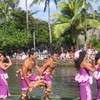A great loss for Nepal and for all the ecology conservationists around the world. Condonlences to all their families and may their souls RIP.
BTW, I had the chance of meeting up with Dr. Harka Gurung a long long time ago (his sons are friends of mine) and since then I held a high amount of reverence for this man not only for what he had done for Nepal (academically) but also for the empowerment of Nepal's "matwalis". His book, "Vignettes of Nepal" was my favorite read at the library during my days at St. Paul's. And what Kanak Dixit said couldn't have been more appropriate: "Harka Gurung, the Nepali who introduced Nepal to Nepalis." (He certainly did for me through his "Vignettes..." book).
To lose a man posessing such principles and values as Dr. Gurung did, is an irreplaceable loss to Nepalis everywhere...My sincerest condolences to his family left behind and I also bereave with all of Nepal's indigeous groups. He will be missed greatly.
I can't wait for the investigation into Shree Airlines begin and all parties held liable punished to the fullest extent of the law.
http://www.nepalitimes.com/issue/317/Remembrance/12572.
Dr. Gurung
A Tribute by Kanak Mani Dixit
A helicopter hits a mountainside, and wipes out an entire pantheon of Nepal’s best and brightest, who believed in returning the commons to the people. These professionals, who, along with some equally committed foreign friends, were returning to Kathmandu having handed over the management of the Kangchenjunga Conservation Area to the local inhabitants. They were the gift of the central Himalaya, of Nepal, to the world. Each was a life full of creativity, courage, and Himalayan exhilaration, and will be remembered decades hence for how they helped define Nepal’s future on the foundation of natural science, geography, and respect for people.
Seated in that helicopter was Harka Gurung, the Nepali who introduced Nepal to Nepalis. He was born in 1938 fast by the Ngadi Khola in upper Lamjung. Growing up at a time when Kathmandu Valley was ‘Nepal’, he decided to reject the ancestral call of Gurkha warriorship, and chose instead the path of scholarship. He ran away barefoot to Kathmandu, where he joined Darbar High School. Then it was onward to ‘lain chhokra’ schools in India, an IA back at Tri Chandra College, a Bachelor’s from Patna University—and a PhD on the geography of Pokhara Valley from Edinburgh University in 1965.
That was a time, so soon after the eclipse of the Ranas, when Nepalis of ‘ethnicity’ were near-invisible on the national scene. Those outside the country, descendants of migrants, were able to rise to the level of their genius; within Nepal, however, Kathmandu’s autocratic glass ceiling allowed no exception. It was by dint of his personality and steely determination, his rigour and love of learning, that Dr Gurung became a one-man role model and pillar of strength for the rest of emerging Nepal.
His first calling was geography, but Dr Gurung was a multi-tasking multi-disciplinarian who delved into planning, demography, art (under Bal Krishna Sama), history (of mountaineering, hill migration, Gurkha recruitment), economics—and, most recently, transparency in governance. He was once Minister of Tourism, in the middle of the Panchayat era, and we have never had someone in that position who better understood the country’s cultural and natural wealth. Over the past decade, amidst the tide of righteous ethnic assertion, Dr Gurung was an exemplar, himself intensely concerned about overturning the national legacy of exclusion.
Dr Gurung had the stature and learning that allowed him not to be cowed by possibility of controversy. In 1983, he was pilloried for a report on migration that suggested regulation of the southern border. Last year, ICIMOD published a detailed monograph with four decades worth of photographic evidence from his native Lamjung. In it, Dr Gurung sought to debunk the ‘theory of Himalayan degradation’, which seeks to place the blame for downstream siltation and flooding at the doorstep of the midhill peasantry and its supposed biomass profligacy.
Ever the genial contrarian, Dr Gurung scoffed at the tradition, powered by the myth that it was a holy mountain, of not allowing mountaineers on Machapuchre. He maintained that there was no evidence the Gurung herders inhabiting its base in fact revered Machapuchre. A student of mountaineering history, he suggested that the first climbers of Nepal were not the Sherpas but Gurkha lahurays, starting with Karbir Budathoki and Harkabir Thapa in the Swiss Alps in 1884.
Dr Gurung believed in the power of statistics to reveal and thereby help improve the human condition, and so his latest immersion was in producing the book Nepal: Atlas and Statistics. A large-format work in preparation for three full years, it emerged from the printers the day before the author and editor left for Ghunsa at the base of Kangchenjunga. Himal Books, the publishers, was preparing for a grand presentation by Dr Gurung after the Dasain break. It will now have to be done in absentia.
Author of the widely-acclaimed Vignettes of Nepal (1980), among more than a dozen equally gripping and authoritative works, Dr Gurung’s life cannot be encapsulated other than through vignettes. One of his most prized possessions was a set of black-and-white photographs following the march of the Himalayan ramparts, taken from a Pilatus Porter flight that he took across the 500-mile spine of Nepal.
When it came time to christen scores of the country’s peaks so that they did not all get named by western climbers and cartographers, and alternatively to save them from the fate of mere numericals, it was Dr Gurung who was handed the task. That was also how Peak 29, towering above his home village in central Nepal, became Ngadi Chuli. Across the Nepal Himalaya, thus Harka Gurung left his personal stamp on the chulis, and it was amidst the craggy cliffs of the lower Himalaya, in Taplejung in the east, that he himself returned to nature.
Coming down from Manang a few years ago, and passing Ngadi Khola, a porter pointed out to me a collection of houses up the slope to the left. He said, “That one, with the kitchen smoke, is the house of Harka Gurung.” It is by that wisp of smoke in his beloved Ngadi that I prefer to remember Dr Gurung.
















